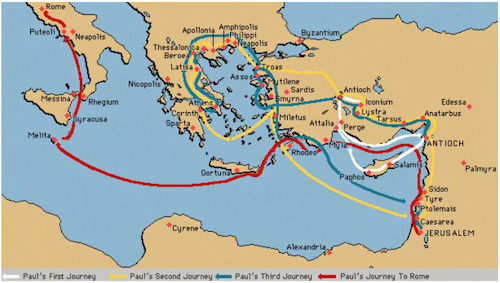
[15] But the Lord said to [Ananias], “Go, for he is a chosen instrument of mine to carry my name before the Gentiles and kings and the children of Israel.
For those following the lectionary of the BCP2019, we pause our reading in Genesis to mark the Conversion of St. Paul (Saul).
The symbol here is the road.
The choice of place and circumstance of Paul’s conversion is not coincidental.
Saul (future Paul) has a letter from the high priest in Jerusalem to capture and kill Christians: He has a commission.
This is the first place in scripture where Christians are called those “belonging to the Way” [2].
Jesus meets Saul on the road.
Paul reverses direction—repentance and faith.
Jesus lays him flat on the road.1
Jesus sends him into darkness, with blinding light.
These are images of “sleep” and “death”—out of the dream-like illusion of the world as Saul believes it to be, into the world as it actually is, from the deception of night to the clarity of day.
After three days (!!) in this “death,” Saul “wakes up” or “resurrects,” when the scales fall.
God tells Ananias to find Saul on “Straight Street,” a detail we need only for its symbolism.
Paul’s future is the road.
He is the missionary apostle, primus inter pares, of the New Testament.
The Book of Acts begins with Jesus commissioning his disciples “to the end of the earth.” [1:8]
It ends with Paul bearing witness of Christ to Caesar in Rome.2
Bible scholars see this as the fulfillment (or a sign of the fulfillment, I might say) of that promise.
So once again, this is not a metaphor, but a symbol having real-life actualization.
In the wilderness prepare the way of the Lord; make straight in the desert a highway for our God. (Isaiah 40:3)

He is thrown from his horse, a symbol of his hierarchy upended, his world overturned.
Roman roads are an engineering marvel, as the image at the top indicates. They literally paved the way for the advancement of the gospel.



